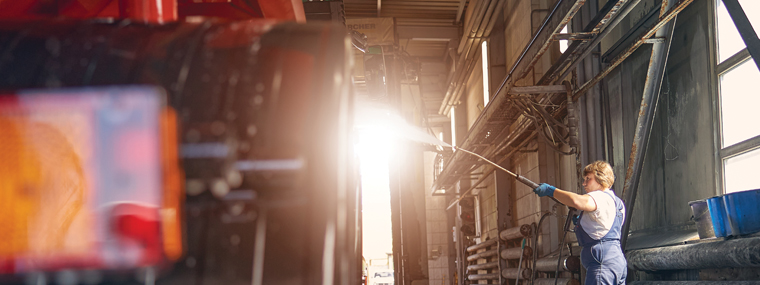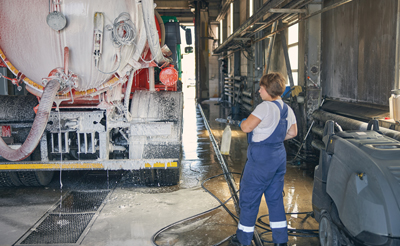
Setting up a Commercial Drive-Through Wash
By Diane M. Calabrese / Published May 2021

Full speed ahead. After due diligence, why not?
Many contractors stall before moving into a venture like a commercial drive-through wash. Start-up costs and environmental regulations loom large—usually larger than they should—and the contractor decides against proceeding.
It’s true enough that if things go wrong a business owner can lose a lot more money than if he or she started an in-home dog-washing service. But why not focus on the return a successful commercial drive-through wash would bring?
Paul Horsley, the president of Paul Horsley Consulting and the former owner of Scotts Pressure Wash in Calgary, Alberta, assists entrepreneurs with their business plans and strategy. Part of his deep experience in the power washing industry includes previously owning a drive-through truck wash.
Among all the aspects—from cost and layout to potential volume of business—that a prospective commercial owner must consider, does one take precedence? “My suggestion would be space,” says Horsley, explaining space can be too easily overlooked as all the other criteria are met.
“You want a location where you can line up a large number of trucks,” explains Horsley. “Once you build a truck wash, they will come.”
If there is no place for trucks to queue, the drivers will keep right on going. Most definitely, that’s not the way to build a business.
Other important primary considerations for a would-be commercial wash owner include the cost of water. In the United States water rates vary widely with jurisdiction. The commercial wash must be able to pay the rates, and that requires a sufficient volume of customers.
Commercial washes must be based in a large enough city to support a steady customer base, explains Horsley. Areas with trucking or shipping hubs are particularly good prospects.
At his website, Horsley provides a link to a discussion that commercial wash owners who are members of PWNA had about the future of truck washing. (See http://www.paulhorsley.ca/wp-content/uploads/2011/08/FutureOfTruckWashing.pdf.) Although the discussion took place ten years ago, the factors affecting decisions made by current and prospective owners of commercial washes remain the same.
The factors—fuel costs, difficulties in hiring and retaining employees, pay structure, environmental regulations, competitors—are not unique to commercial washes. But they are discussed in the context of the sector, which makes the roundtable well worth reading.
In 2015 in the pages of Cleaner Times, Michael Hinderliter, the president of Steamaway Inc. in Fort Worth, TX, wrote about the uniqueness of every job in fleet/truck washing. (See https://www.cleanertimes.com/magazine/cleaner-times-articles-2/fleettruck-washing-every-job-is-different/.) His article is a particularly good source of information for contractors who are thinking about offering mobile services.
Companies with fleets typically do their own washing or contract for the service. When they contract, many companies still want the trucks washed on their own sites. A company that sets up a successful drive-through wash may receive inquiries from fleet—both truck and car—owners about its availability to travel to a customer’s site and do the washing there.
Finding a balance between a facility with wash bays and travel to customer sites can be tricky. Modern wash bays with grit traps ease the process of handling wastewater, including recycling, contaminants, and removal. At a fleet owner’s site, a commercial wash owner must have a reliable portable collection system or use a system the fleet operator has in place.
Drive-through washes make containment easier. Although going to a customer’s site may add complexity, it brings some opportunities as well. Among them are trailers of all kinds that need to be cleaned.
Cleaning trailers adds to the precautions that must be taken. If employees work inside trailers, they are subject to rules for confined spaces. Depending on what the trailers have been used to haul, such as perishable food or medical supplies, there may be specific guidelines from government entities about how the trailers are to be cleaned.
Opportunities to add on services should not be overlooked in drive-through washes. Mats, dash, and seat cleaning may be add-ons or consolidated in a price for washing that includes the interior of cabs. Vacuuming of carpeting and upholstery in vehicles of all sorts is another effort that speaks to add-on or a higher, bundled price (i.e., exterior wash and interior cleaning.)
Regulation of commercial drive-through washes (and mobile wash services) is tighter in some localities than others. Nevertheless, following the best practices in water and chemical use should be the policy of everyone because it enhances the reputation of practitioners and strengthens the industry.
Look first to the local community for regulatory guidance and permitting requirements. For example, the Texas Commission on Environmental Quality (TCEQ) advice covers everything from wash water and grit-trap waste to fuel tanks and emissions. It includes the reminder that plumbing ordinances many come into play as additional requirements.
Environmental regulators generally look favorably on commercial drive-through washes. It makes sense, given commercial entities will understand and adhere to standards for water and chemical use. In fact, many communities encourage their residents to use commercial washes.
In the future, encouragement may switch to a requirement. If it does, the need for commercial drive-through washes—truck and car—will be greater than it is now.
Adding Up The Costs
For contractors who want to take a no-nonsense approach to computing the cost of setting up a commercial drive-through wash, we recommend a document from the IRS. Yes, the Internal Revenue Service.
Cash Intensive Businesses Audit Techniques Guide—Chapter 11—“Car Wash” (https://www.irs.gov/pub/irs-utl/cashchapter11_211031.pdf) in the hands of a would-be commercial wash owner stands as an outline of the varied expenses to be considered. (Auditors use it to track potential underreporting of profit or over-reporting of expenses.)
Referring to the IRS auditing document, we relay some questions a prospective commercial drive-through wash owner should be able to answer before become committing to ownership:
Which type of drive-through? Self-serve automatic bay, self-serve touchless automatic bay, and full-service tunnel are the three big categories. Options such as presoak or pre-rinse may be part of touchless automatic bays. Tunnels may include more options, such as undercarriage wash. Each configuration deploys staff in a different way, from attendant to engaged contributor (wiping, waxing). Safety concerns have taken many customers out of their vehicles, even in self-serve automatic drive-through washes.
 Will the commercial wash be tied to another business? More than 50 percent are tied to fuel service stations. Some are combined with detailing shops. Others are tied to general automotive repair facilities.
Will the commercial wash be tied to another business? More than 50 percent are tied to fuel service stations. Some are combined with detailing shops. Others are tied to general automotive repair facilities.
How much will water, sewer, and electricity cost? Self-service bays are most energy efficient. Full-service tunnels consume the most electricity. Water and sewer charges vary dramatically with location. The expenses will be deductible, but they must also be affordable. If they push the charge for a wash so high customers go elsewhere (easy enough for long-haul truckers), the facility might not be a feasible venture at a particular location.
What will be the cost of soap/chemicals? Auditors can actually go to the manufacturer/distributor from which a commercial wash buys to verify expenditures. The owner of a wash should be as serious about getting cost projections on the front side.
Can the facility operate in most weather conditions? Auditors can look at NOAA data to ascertain that a facility has not been closed due to weather events. Look at records of weather for a location where the wash will be sited. Is there a pattern of bad weather—heavy snow, flooding—that would make the site a poor choice?
What constitutes a realistic value for water use? On page 10 of the IRS document, a method for determining water consumption is given. Used by an owner of a commercial wash, the method allows for computing the likely cost of water/sewer—and how that amount contributes to the cost of a wash per vehicle. (The auditors use the method to verify that vehicles reported washed are not underreported.)
How much will chemicals cost? Yes, there is also a method for measuring soap/chemical consumption that auditors use to look for inconsistencies in income reporting. Again, it’s very useful in reverse. Note the auditors do take into account how dilution rates vary with pressure of water, hardness of water, owner preferences, nozzle sizes, and such.
What are the costs of labor and benefits? Be extremely cautious in defining employees as independent contractors.
What sort of depreciation schedule fits tunnels (and other drive-through line components) and buildings? Use the depreciation schedule in the inverse to get a handle on the durability of equipment.
What will the tax load be on the business? Tally all levels of taxation. Also, include the cost of collecting sales taxes, if required to do so.
What’s a weep system? (Just testing.) It’s one of many terms in the glossary of the audit document. It interests auditors because the system increases water use in winter, so more water use does not always correlate directly with more vehicles washed.
Ownership of a commercial drive-through wash may be an excellent venture. Before leaping though, just be sure to have as thorough an understanding of the cost and profit centers as the IRS does.






